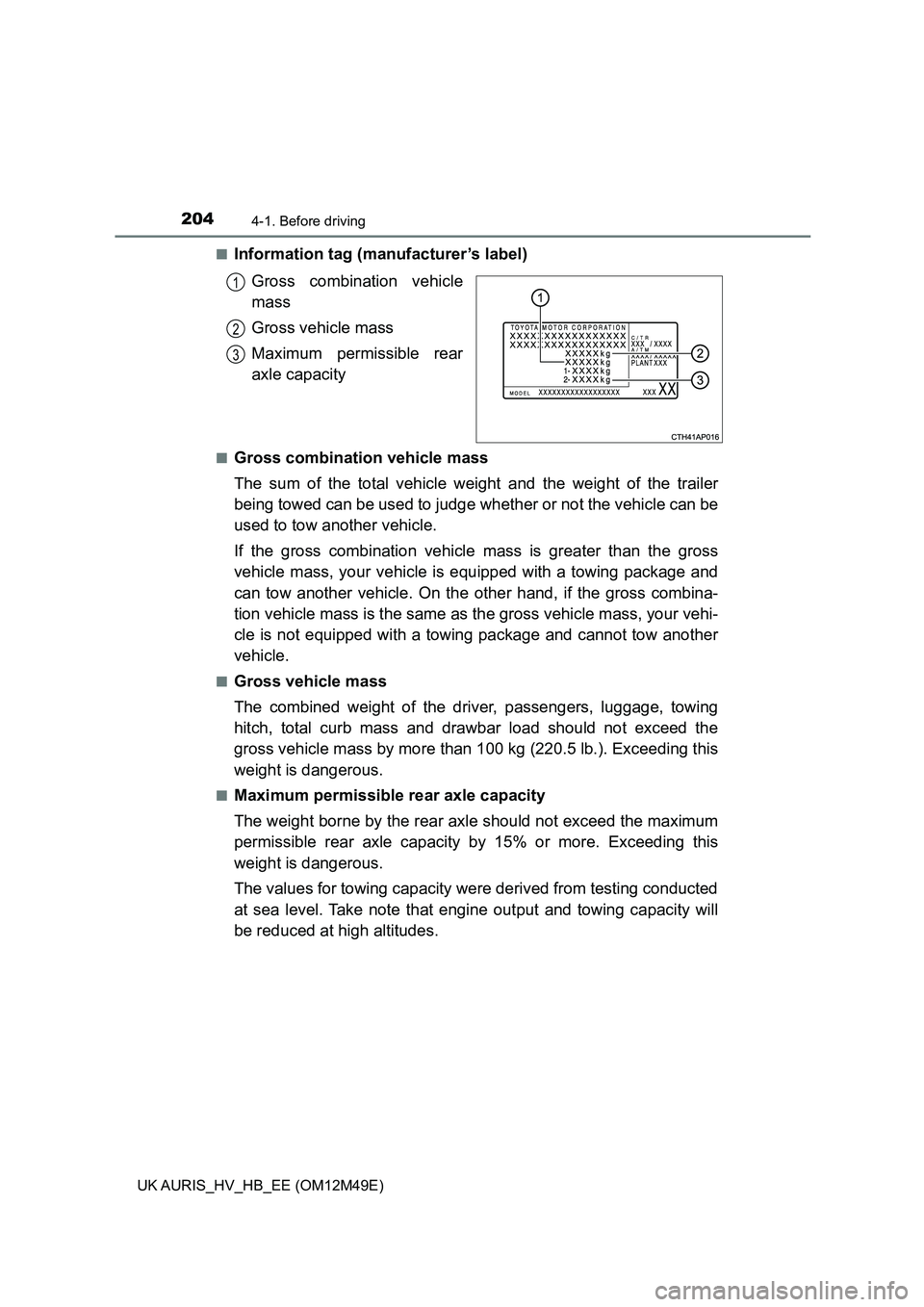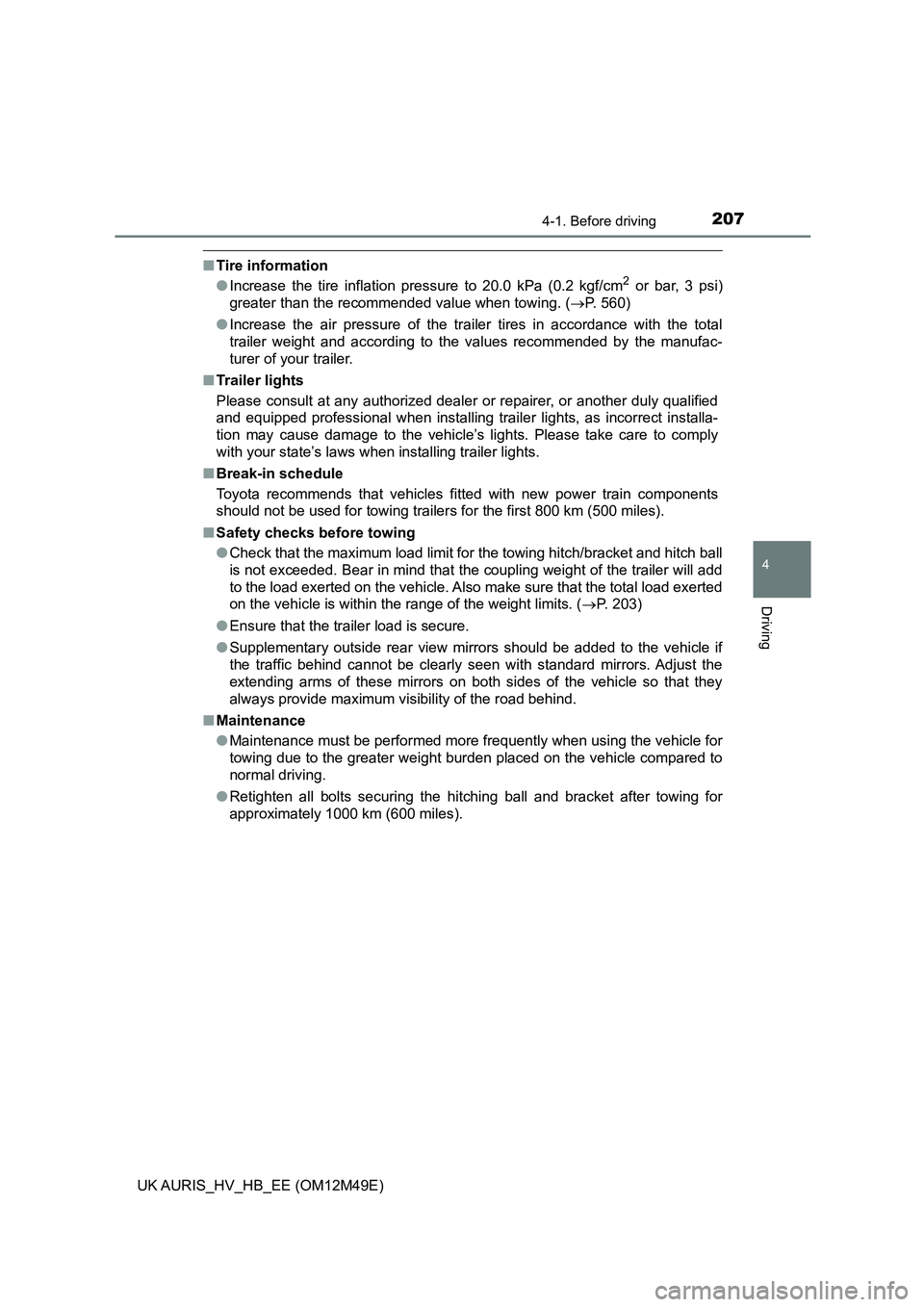Page 202 of 592

2024-1. Before driving
UK AURIS_HV_HB_EE (OM12M49E)
◆Weight limits
Check the allowable towing capacity, GVM (Gross Vehicle Mass),
MPAC (Maximum Permissible Ax le Capacity), and permissible
drawbar load before towing. ( P. 552)
◆Towing hitch/bracket
Toyota recommends the use of the Toyota hitch/bracket for your
vehicle. Other products of a su itable nature and comparable quality
may also be used.
Vehicles with a towing package
Your vehicle is designed primarily as a passenger carrying vehi-
cle. Towing a trailer will have an adverse effect on handling, per-
formance, braking, durability, an d fuel consumption. Your safety
and satisfaction depend on the pr oper use of correct equipment
and cautious driving habits. Fo r your safety and the safety of
others, do not overload the vehicle or trailer.
To tow a trailer safely, use extreme care and drive the vehicle in
accordance with the trailer’s characteristics and operating con-
ditions.
Toyota warranties do not apply to damage or malfunction
caused by towing a trailer for commercial purposes.
Ask your local authorized Toyota dealer or repairer, or another
duly qualified and equipped professional for further details
before towing, as there are a dditional legal requirements in
some countries.
Page 203 of 592
2034-1. Before driving
UK AURIS_HV_HB_EE (OM12M49E)
4
Driving
■Total trailer weight and permissible drawbar load
Total trailer weight
Weight of the trailer itself plus
the trailer load should be within
the maximum towing capacity.
Exceeding this weight is danger-
ous. ( P. 552)
When towing a trailer, use a fric-
tion coupler or friction stabilizer
(sway control device).
Permissible drawbar load
Allocate the trailer load so that the drawbar load is greater than 25 kg
(55.1 lb.) or 4% of the towing capacity. Do not let the drawbar load
exceed the indicated weight. ( P. 552)
Important points regarding trailer loads
1
2
Page 204 of 592

2044-1. Before driving
UK AURIS_HV_HB_EE (OM12M49E)
■Information tag (manufacturer’s label)
Gross combination vehicle
mass
Gross vehicle mass
Maximum permissible rear
axle capacity
■Gross combination vehicle mass
The sum of the total vehicle weight and the weight of the trailer
being towed can be used to judge whether or not the vehicle can be
used to tow another vehicle.
If the gross combination vehicle mass is greater than the gross
vehicle mass, your vehicle is e quipped with a towing package and
can tow another vehicle. On the other hand, if the gross combina-
tion vehicle mass is the same as the gross vehicle mass, your vehi-
cle is not equipped with a towing package and cannot tow another
vehicle.
■Gross vehicle mass
The combined weight of the driver, passengers, luggage, towing
hitch, total curb mass and drawbar load should not exceed the
gross vehicle mass by more than 100 kg (220.5 lb.). Exceeding this
weight is dangerous.
■Maximum permissible rear axle capacity
The weight borne by the rear ax le should not exceed the maximum
permissible rear axle capacity by 15% or more. Exceeding this
weight is dangerous.
The values for towing capacity were derived from testing conducted
at sea level. Take note that e ngine output and towing capacity will
be reduced at high altitudes.
1
2
3
Page 205 of 592
2054-1. Before driving
UK AURIS_HV_HB_EE (OM12M49E)
4
Driving
WARNING
■When the gross vehicle mass or maximum permissible axle capacity is
exceeded
Failing to observe this precaution may lead to an accident causing death or
serious injury.
● Add an additional 20.0 kPa (0.2 kgf/cm2 or bar, 3 psi) to the recommended
tire inflation pressure value. ( P. 560)
● Do not exceed the established speed limit for towing a trailer in built-up
areas or 100 km/h (62 mph), whichever is lower.
Page 207 of 592

2074-1. Before driving
UK AURIS_HV_HB_EE (OM12M49E)
4
Driving
■Tire information
● Increase the tire inflation pressure to 20.0 kPa (0.2 kgf/cm2 or bar, 3 psi)
greater than the recommended value when towing. ( P. 560)
● Increase the air pressure of the trailer tires in accordance with the total
trailer weight and according to the values recommended by the manufac-
turer of your trailer.
■ Trailer lights
Please consult at any authorized dealer or repairer, or another duly qualified
and equipped professional when installing trailer lights, as incorrect installa-
tion may cause damage to the vehicle’s lights. Please take care to comply
with your state’s laws when installing trailer lights.
■ Break-in schedule
Toyota recommends that vehicles fitted with new power train components
should not be used for towing trailers for the first 800 km (500 miles).
■ Safety checks before towing
● Check that the maximum load limit for the towing hitch/bracket and hitch ball
is not exceeded. Bear in mind that the coupling weight of the trailer will add
to the load exerted on the vehicle. Also make sure that the total load exerted
on the vehicle is within the range of the weight limits. ( P. 203)
● Ensure that the trailer load is secure.
● Supplementary outside rear view mirrors should be added to the vehicle if
the traffic behind cannot be clearly seen with standard mirrors. Adjust the
extending arms of these mirrors on both sides of the vehicle so that they
always provide maximum visibility of the road behind.
■ Maintenance
● Maintenance must be performed more frequently when using the vehicle for
towing due to the greater weight burden placed on the vehicle compared to
normal driving.
● Retighten all bolts securing the hitching ball and bracket after towing for
approximately 1000 km (600 miles).
Page 254 of 592

2544-5. Toyota Safety Sense
UK AURIS_HV_HB_EE (OM12M49E)
WARNING
●While driving, such as when driving through a railway crossing, the system
may determine that the possibility of a collision with an object, such as rail-
way crossing barrier, is high and operate the pre-crash braking function.
To move the vehicle in an emergency, such as if the system operates in a
railway crossing, perform the following operations and then take the nec-
essary measures to ensure your safety.
• If the vehicle has been stopped, depress the accelerator pedal.
• If the vehicle is decelerating, fully depress the accelerator pedal.
( P. 256)
• Disable the pre-crash safety system. ( P. 255)
■ When to disable the pre-crash safety system
In the following situations, disable the system, as it may not operate prop-
erly, possibly leading to an accident resulting in death or serious injury:
● When the vehicle is being towed
● When your vehicle is towing another vehicle
● When transporting the vehicle via truck, boat, train or similar means of
transportation
● When the vehicle is raised on a lift with the hybrid system on and the tires
are allowed to rotate freely
● When inspecting the vehicle using a drum tester such as a chassis dyna-
mometer or speedometer tester, or when using an on vehicle wheel bal-
ancer
● If the vehicle cannot be driven in a stable manner, such as when the vehi-
cle has been in an accident or is malfunctioning
● When the vehicle is driven in a sporty manner or off-road
● When the condition of the tires is poor and they do not perform well
( P. 439, 454)
● When tires of a size other than specified are installed
● When tire chains are installed
● When a compact spare tire or an emergency tire puncture repair kit is used
Page 487 of 592
4878-2. Steps to take in an emergency
UK AURIS_HV_HB_EE (OM12M49E)
8
When trouble arises
Take out the towing eyelet. (P. 508, 521)
Remove the eyelet cover using
a flathead screwdriver.
To prevent damage, cover the tip of
the screwdriver with a rag.
Insert the towing eyelet into the
hole and tighten partially by
hand.
Tighten down the towing eyelet
securely using a wheel nut
wrench* or hard metal bar.
*: If the vehicle is not equipped with a
wheel nut wrench, a wheel nut
wrench can be purchased at any
authorized Toyota dealer or
repairer, or another duly qualified
and equipped professional.
Securely attach cables or chains to the towing eyelet.
Take care not to damage the vehicle body.
Enter the vehicle being towed and start the hybrid system.
If the hybrid system does not start, turn the power switch to ON mode.
Shift the shift position to N and release the parking brake.
Emergency towing procedure
1
2
3
4
5
6
7
Page 552 of 592
552
UK AURIS_HV_HB_EE (OM12M49E)
9-1. Specifications
*1: Unladen vehicles
*2: Vehicles with 195/65R15 tires
*3: Vehicles with 205/55R16 tires
*4: Vehicles with 225/45R17 tires
*5: Gross vehicle mass is specified on the information tag (manufacturer’s
label). (P. 204)
*6: Vehicles with towing package (P. 201)
Maintenance data (f uel, oil level, etc.)
Dimensions and weights
Overall length 4330 mm (170.5 in.)
Overall width 1760 mm (69.3 in.)
Overall height*11475 mm (58.1 in.)
Wheelbase 2600 mm (102.4 in.)
Tread
Front
1535 mm (60.4 in.)*2
1525 mm (60.0 in.)*3
1515 mm (59.6 in.)*4
Rear
1525 mm (60.0 in.)*2
1515 mm (59.6 in.)*3
1505 mm (59.3 in.)*4
Gross vehicle mass*51840 kg (4057 lb.)
1815 kg (4002 lb.)
Maximum permis-
sible axle capacity
Front 1020 kg (2249 lb.)
Rear 1010 kg (2227 lb.)
Drawbar load*655 kg (121 lb.)
Towing capacity*6385 kg (848 lb.)